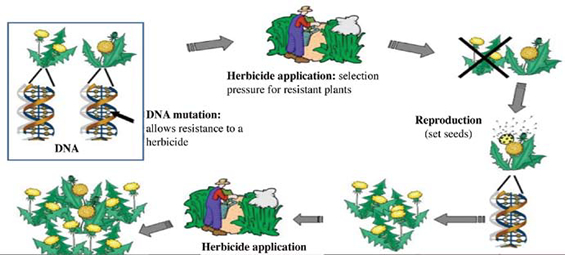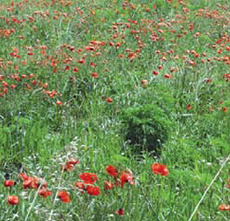Evolution and Management of Herbicide-Resistance
Herbicides are the primary economic means to control weeds and they play a crucial role in helping humanity feed itself. The evolution of herbicide-resistant weeds is a serious problem facing the global agricultural community — they threaten regions, economies and the livelihoods of farming families. But herbicide resistance can be managed. Cereals Magazine Editor Mr. Masila Kanyingi spoke to Evelyne Pamba, Intergrated Field Scientist, Corteva Agriscience to elaborate it further and help farmers understand it better. Below are the Excerpts
 Briefly define a weed?
Briefly define a weed?
A weed can be a plant growing where it is not wanted or plant out of place. It can also be referred to a plant that is a nuisance or a plant that is undesirable.
What is Herbicide?
Herbicide is defined as a plant protection product used to eliminate unwanted plants or prevent them from growing while leaving the desired crop. It can be either selective or non-selective. Selective herbicides clear unwanted plants while leaving the desired crop unharmed while on the other hand non-selective herbicide will kill all the plants they come in contact with.
Agronomists are warning farmers on herbicide resistance, can you explain this in a layman’s language?
Globally we have a body known as HRAC (Herbicide Resistance Action Committee). This is an international body founded by the agrochemical industry, helps to protect crop yields and quality worldwide by supporting efforts in the fight against herbicide-resistant weeds. It defines Herbicide resistance as the natural ability of a weed biotype to survive an application of an herbicide that previously killed it.
A number of cases of herbicide resistance have been documented in more than 100 weed species around the world. These weeds present on-going challenges to growers and the agriculture industry.
It is important to note that herbicide resistance does not imply poor performance of the product or herbicide tolerance (the inherent ability of a species to survive and reproduce after herbicide treatment at a normal use rate)-Normally never used to kill it from the beginning.
 What factors favour resistance development?
What factors favour resistance development?
Farmers will always use what is working for them. However, it is important to note that a repeated use of a specific herbicide or a combination of herbicides with same mechanism of action can result to resistance because we are increasing the selection pressure. In addition, weed populations with wide genetic diversity may also develop resistance rapidly, especially for herbicides with a single mechanism of action.
Within any weed population there may be some plants that already contain a rare change in a gene (or genes) that enable them to survive the application of a particular herbicide that would normally kill this species. Genetic variation may alter physiological traits that enable herbicide uptake, translocation and activation at the site of action. Alternatively, changes may influence the plant’s ability to detoxify herbicides, or enable transport to a site within the plant where the herbicide is not lethal. Each time the herbicide is applied, susceptible plants die and those with resistance survive.
Resistance occurs where diversity in management is low. Monocrop, big farms, lack of mechanical and/or cultural control methods, use of only one mechanism of action herbicide increases the selection pressure of plants resistant to a method of control. Resistance could affect whatever method we use repeatedly.
Lastly, resistance is also influenced by a high genetic diversity (pollination type, population size) and fecundity (nº of seed per plant), high rates of weed migration/ spread, and diverse environmental conditions.
Discuss the different types of herbicide resistance
We have mainly two types of known resistance, namely;
Cross resistance: This occurs when a weed population is resistant to more than one herbicide subgroup within similar MOA group. For example, populations of wild oats that are resistant to group A ‘fops’ Aryloxyphenoxy-propionate (e.g. fenaxaprop) may also be resistant to group A ‘dims’, Cyclohexanedione (e.g. tralkoxydim) even though they have not been exposed to a herbicide from the ‘dim’ subgroup. This is usually target-site resistance. It may arise without the weed population ever being exposed to one of the herbicides. Multiple resistance: Multiple resistance is a term used to describe weed populations that exhibit more than one resistance mechanism, allowing the plant to withstand herbicides from different subgroups. Some populations of resistant annual ryegrass possess both target and non-target site resistance. For example, one population of annual ryegrass exhibits resistance to five different herbicide MOA groups.
Describe the different types of resistance mechanisms?
The two common mechanisms of resistance to herbicides are:
Target-site Resistance: This results from mutations that alter the herbicide binding site (often within an enzyme) preventing or reducing the ability of an herbicide to bind to the target site, allowing the target-site protein to remain functional. Where the herbicide has such little inhibitory effect on the site of action, plants may survive greater than 10 times the normal herbicide rate (considered high-level resistance).
Mechanisms of action where high-level resistance is most often seen include ACCase, ALS, triazines, dinitroanaline and photosystem II inhibitors.
 Metabolic Resistance (Non-target Site): Non-target site resistance (also referred to as metabolic resistance) is used to describe mechanisms other than changes at the target site which enable an individual plant to survive an herbicide application. The potential mechanisms include reduced herbicide uptake, reduced translocation, reduced herbicide activation, enhanced herbicide detoxification, changes in intra or inter-cellular compartmentalization and enhanced repair of herbicide-induced damage.
Metabolic Resistance (Non-target Site): Non-target site resistance (also referred to as metabolic resistance) is used to describe mechanisms other than changes at the target site which enable an individual plant to survive an herbicide application. The potential mechanisms include reduced herbicide uptake, reduced translocation, reduced herbicide activation, enhanced herbicide detoxification, changes in intra or inter-cellular compartmentalization and enhanced repair of herbicide-induced damage.
This type of resistance is more complex than altered target –site resistance type because it involves several plant processes. Plants with altered metabolism resistance can degrade several unrelated herbicides of different modes of action through multiple genes controlling metabolic processes. Plant injury may occur because plants cannot rapidly degrade absorbed herbicide, causing this mechanism to be considered low-level resistance. Increasing the herbicide rate to smaller plants may control more plants.
What is selection pressure?
Selection pressure is a term used to describe the amount of selection for resistance applied by the herbicide application. Every time an herbicide is used, susceptible individuals are killed and resistant individuals survive. The greater the number of resistant individuals that survive, the higher the selection pressure.
How can you manage herbicide resistance?
Remember, the key to prevention of herbicide resistance is to reduce selection intensity and utilize herbicides with restraint within an overall Integrated Weed Management strategy.
Cultural Practices:
- Rotate crops (particularly those with different life cycles)
- Incorporate non-chemical weed control measures
- Use cultivation and mechanical hoeing where possible. Also consider post-harvest grazing, mowing, stubble burning, etc to prevent seed set or survival.
- Delay planting to allow removal of initial weed flushes
- Use weed-free or certified crop seed and manage crop to maximize competition
- Use tillage as a component of the weed management program.
- Scout fields regularly to identify potential issues and eliminate weed escapes. Keep good records of weed populations.
- Prevent spread of resistant weeds by thoroughly cleaning tillage and harvest equipment as it moves from field to field. Also do not allow resistant weeds from total vegetation control areas (i.e. fence rows, railroads, public utilities, etc) to spread to cropland.
Herbicide Management Practices:
- Use herbicides only when necessary applications should be made based on economic thresholds
- Rotate herbicides with different sites of action
- within and across successive field seasons
- Apply herbicides in tank-mixed, prepackaged or sequential mixtures that include multiple sites (modes) of action
- Follow label directions for recommended use rates and application timings to ensure best efficacy
- Monitoring of weeds escapes after herbicide application.
Give your final comments?
The fight against herbicide-resistant weeds is now at a critical point. For more than 40 years farmers have coped with herbicide resistant weeds because the industry provided them with a relatively steady stream of new herbicides with novel herbicide sites of action. This is no longer the case now, industry has been slow in innovations and the rapid rise of multiple resistance in weeds leaves many farmers with increasingly intractable weed control problems.
The best resistance-management strategies will involve the use of every available weed control tool (integrated weed management) in an effort to disrupt and destabilize weed populations to prevent them becoming a serious problem. We should try to be unpredictable when managing weeds and apply as much diversity as possible.
Regardless of whether resistance has appeared in a field, crop production systems that involve use of herbicides should always incorporate other practices to prevent and manage for its eventual occurrence.